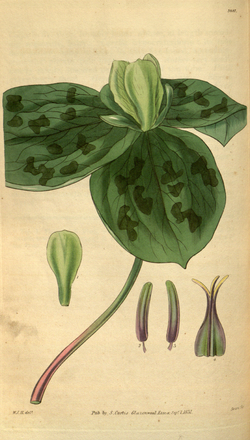| Trillium discolor | |
|---|---|
 | |
| 1831 Illustration [1] | |
| Scientific classification | |
| Kingdom: | Plantae |
| Clade: | Tracheophytes |
| Clade: | Angiosperms |
| Clade: | Monocots |
| Order: | Liliales |
| Family: | Melanthiaceae |
| Genus: | Trillium |
| Species: | T. discolor |
| Binomial name | |
| Trillium discolor | |
| Synonyms [3] | |
| |
Trillium discolor, the mottled wakerobin, [4] pale yellow trillium, or small yellow toadshade, [5] is a species of flowering plant in the family Melanthiaceae. It is native to areas of the Savannah River drainage system of Georgia, North Carolina and South Carolina [6] such as Steven's Creek Heritage Preserve and Lake Keowee. It is found along moist stream banks in upland woods, on acidic to basic soils. [7]

